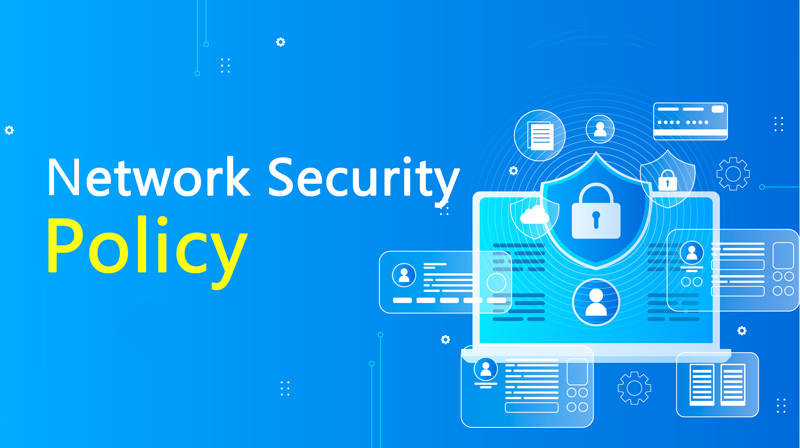Network Security Policy Example & 11 Essentials
Specific regulations and procedures must follow the security of an organization's computer network. A network security strategy outlines these. It functions similarly to a strategy, providing rules for protecting data, restricting access, and mitigating dangers. A company network security policy is essential in this digital age, where cyber risks are shared. It implements a proactive defense system that safeguards private data from hackers, data breaches, and unauthorized users.
This strategy ensures a company's network's security and creates trust among all parties involved, resulting in a secure digital environment in which business may thrive.
You now understand the concept of what is a network security policy. Let's go over this in greater detail.

Part 1: 11 Essentials of a Network Security Policy
Network Security Policy is the most critical thing we can do to protect and secure our information assets. By adhering to these 11 fundamentals, we improve our defenses against potential gaps, ensuring our network security is always strong.
1) Roles and Responsibilities of Each Individual
Any network security plan will only be effective if three key groups collaborate effectively: management, the IT department, and working staff. Management is responsible for supporting and executing this policy as the guardians of the company's strategic purpose. At the same time, IT staff is responsible for implementing and maintaining network security measures.
Employees play an essential role by following the regulations and reporting any security issues as soon as they arise.
2) Access Control Policies
Access Control Policies are critical for network security because they specify who has access and how to grant or revoke that access. These laws establish stringent standards to ensure that only authorized individuals can access private data.
3) User Authentication
Using robust authentication mechanisms, such as multi-factor authentication, improves overall security. Only approved individuals can access confidential data and systems in this manner, making it less likely that someone will break in without authorization.
4) Network Protection Strategies & Measures
It is critical to protect networks in multiple ways. Installing firewalls, intrusion detection systems, and encryption algorithms is a part of this. Businesses can develop a strong defense against potential weaknesses by combining strategic and reactive actions.
5) Incident Response Plan
Every security plan must incorporate a meticulously devised incident response strategy. This paper outlines what needs to be done in the event of a security breach, ensuring that everyone works together to get things corrected as soon as possible.
6) Disaster Recovery Plan
It is critical to have a comprehensive catastrophe strategy in place. This plan outlines the procedures that must be performed to restore normalcy following a tragedy.
7) Legal and Regulatory Compliance
Approving by law and following rules are integral components of running any successful business and should not simply be seen as something to be completed for practical reasons.
8) Penalties for Non-Compliance
The repercussions of failing to implement the security policy must be made apparent to help individuals understand how crucial it is to do so. This works as a barrier and demonstrates how critical it is to secure the network environment.
9) User Training and Awareness
Human error is still a significant cause of security breaches. Employees learn about security best practices through user training and awareness initiatives. This reduces the likelihood of security being compromised by accident.
10) Regular Audits
Regular audits are a practical way to ensure the security policy works appropriately. Organizations can ensure that their network security plan remains current and valuable by conducting frequent evaluations that identify and correct potential flaws.
Part 2: An Example of Network Security Policy
The enterprise network security policy template is a comprehensive framework for safeguarding systems and data. The introduction defines the policy's aim and emphasizes protecting information's integrity, privacy, and availability. It also describes how it can be used throughout the organization.
Individuals in the firm have distinct roles and responsibilities, ensuring that everyone understands their specific network security responsibilities. Access control rules are established as part of the policy, covering who can see what resources and how to enable or restrict access. To prevent unapproved access, this security measure aims to safeguard against unwarranted entry.
Security measures for networks are addressed in this paper, including encryption techniques, firewalls, and intrusion detection and prevention systems to ensure they continue to improve continuously. This plan provides a systematic approach to dealing with and mitigating security issues. A disaster recovery plan also contains:
● Procedures for backing up data.
● Recovering systems.
● Ensuring normal business operations restart after a crisis.
Legal and legislative compliance is essential, and the organization ensures its techniques align with industry best practices. The policy specifies penalties for breaking the regulations, emphasizing the importance of obeying the guidelines. There are plans for user training and awareness campaigns to help workers become more aware of security concerns.
A plan for periodic audits is in place to ensure the policy remains effective. Audits ensure that the policy remains current in an ever-changing world by examining and amending it regularly to account for new cybersecurity risks or technological progress. Network security policy templates provide a comprehensive and practical method for enterprises to protect their digital assets.

Part 3: 9 Types of Policies Utilized In Network Security Management
Network security management uses various rules to safeguard an organization's digital assets and information. These nine types of policies are frequently used in network security control:
ACCESS CONTROL POLICY
The Access Control Policy defines rules and procedures for authorizing access to network resources within an organization while outlining who may view which data. Ultimately, this ensures that only authorized people gain entry to sensitive files.
INCIDENT RESPONSE POLICY
It offers a systematic method for recognizing, mitigating, and responding swiftly and cohesively in case of security breaches - to minimize damages while expediting response time.
PASSWORD POLICY
It specifies how lengthy and complicated passwords should be, how frequently they should be updated, and other security steps to prevent anyone from gaining access without authorization using stolen identities.
EMAIL POLICY
This policy explains how to use email securely in the workplace. Guidelines could address how to encrypt emails, permissible activities, and how to reduce risks such as phishing.
REMOTE ACCESS POLICY
Employees of businesses frequently connect to networks from their homes. The remote access policy specifies the regulations and security procedures that must be followed by employees who connect to the firm's network from outside the company.
DISASTER RECOVERY POLICY
When something wrong happens, this policy explains how to recover your IT tools and data. Business continuity plans allow safeguards to backup data, restore systems, and guarantee operations continue uninterrupted.
PRIVACY POLICY
Privacy policies safeguard sensitive personal data by outlining its collection, storage, and dissemination according to applicable privacy laws and regulations.
PHYSICAL SECURITY POLICY
This strategy's purpose is to keep IT assets and infrastructure physically secure. Access controls, monitoring, and environmental controls are among the features incorporated to prevent unauthorized individuals from entering and causing harm.
BYOD POLICY
As more employees bring personal devices into work, a Bring Your Device (BYOD) plan provides recommendations to maintain device safety on company networks. It discusses security processes, acceptable behavior guidelines, and how to keep corporate data secure on personal devices.
Part 4: Network Security Policy Implementation & Management
To stay up with new threats, successful network security policy management must create, enforce, and improve policies constantly. As part of their role as managers, they must train users about the policy daily to keep the network safe.
Regular simulations and exercises help determine which areas of the plan need to be improved and guarantee that security incidents are handled quickly and in a coordinated manner.
Network security plans should be regularly evaluated, audited, and revised to remain up-to-date on emerging threats and technological updates. This proactive measure ensures they stay solid and applicable within a rapidly shifting cybersecurity field.
Various technological tools can help enforce a network security policy. Here are a few examples:
- Firewalls
- Intrusion Detection/Prevention Systems
- Access Control Software
- Security Information and Event Management (SIEM) Systems
- Endpoint Protection Platforms
Part 5: Why Need a Network Security Policy
The implementation of a network security policy brings several key benefits to organizations:
Risk Mitigation
By outlining clear guidelines and measures to manage potential security events such as unauthorized access or data breaches, network security policies help minimize these threats to protect sensitive information and keep systems running optimally.
Regulatory Compliance
Following regulatory guidelines helps avoid legal consequences while building stakeholder trust by showing your commitment to data protection and security.
Incident Response Readiness
A well-defined network security policy prepares organizations to respond to security incidents effectively. This readiness minimizes the impact of breaches, facilitates swift recovery, and helps maintain business continuity.
Still need help? Submit a request >>


